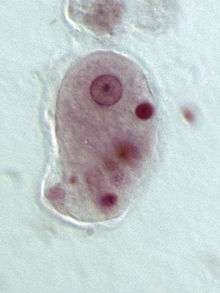Archamoebae
The Archamoebae are a group of protists originally thought to have evolved before the acquisition of mitochondria by eukaryotes.[1] They include genera that are internal parasites or commensals of animals (Entamoeba and Endolimax). A few species are human pathogens, causing diseases such as amoebic dysentery. The other genera of archamoebae live in freshwater habitats and are unusual among amoebae in possessing flagella. Most have a single nucleus and flagellum, but the giant amoeba Pelomyxa has many of each.
| Archamoebae | |
|---|---|
 | |
| Entamoeba histolytica trophozoite | |
| Scientific classification | |
| Domain: | Eukaryota |
| (unranked): | Unikonta |
| (unranked): | Amoebozoa |
| Subphylum: | Conosa |
| Infraphylum: | Archamoebae Cavalier-Smith 1998 |
| Genera | |
|
Endolimax
| |
Description
Archamoebae are a diverse group of amoebae. Many have flagella for motility, while others do not. They grow in the absence of oxygen, though some can tolerate small amounts. Most described species of Archamoebae either lack mitochondria or are described to have reduced mitosomes.[2]
History
The group Archamoebae was proposed by Thomas Cavalier-Smith in 1998 as part of the Archezoa, a newly-proposed group to include eukaryotes that had diverged before acquisition of mitochondria and other common eukaryotic cell features.[3][4] Early molecular trees based on rRNA supported this position, placing several Archamoebae genera as separate groups that diverged from other eukaryotes very early on, suggesting that the absence of mitochondria was a primitive condition.[4] However, soon thereafter genetic remnants of mitochondria were found in various Archamoebae, suggesting that these organisms had diverged after the evolution of mitochondria, but had lost their mitochondria over time, and are more closely related to various amoebae and slime molds.[1]
References
- Williams BP, Keeling PJ (2003-12-09). Littlewood T (ed.). The Evolution of Parasitism - A Phylogenetic Perspective. pp. 30–31. ISBN 9780080493749. Retrieved 20 February 2018.
- Ptáčková, Eliška; Kostygov, Alexei Yu; Chistyakova, Lyudmila V; Falteisek, Lukáš; Frolov, Alexander O; Patterson, David J; Walker, Giselle; Cepicka, Ivan (2013). "Evolution of Archamoebae: Morphological and Molecular Evidence for Pelobionts Including Rhizomastix, Entamoeba, Iodamoeba, and Endolimax". Protist. 164 (3): 380. doi:10.1016/j.protis.2012.11.005. PMID 23312407.
- Cavalier-Smith T (August 1998). "A revised six-kingdom system of life". Biol Rev Camb Philos Soc. 73 (3): 203–66. doi:10.1111/j.1469-185X.1998.tb00030.x. PMID 9809012. Archived from the original on 2012-12-05.
- Keeling PJ. "A kingdom's progress: Archezoa and the origin of eukaryotes" (PDF). BioEssays. 20: 87–95. doi:10.1002/(sici)1521-1878(199801)20:1<87::aid-bies12>3.0.co;2-4. Retrieved 20 February 2018.